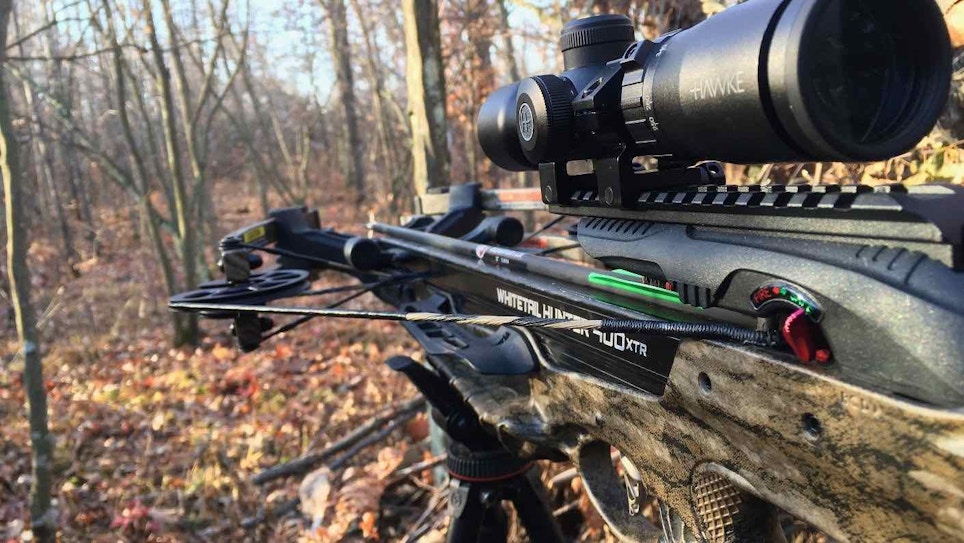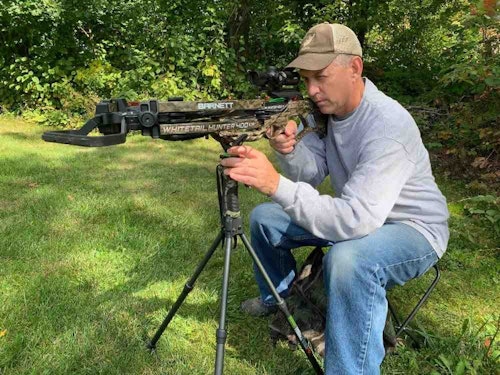
Setting up with too narrow of a shooting lane forces a crossbow hunter to stop a walking deer with a bleat, which in the author’s opinion, greatly increases the odds of it jumping the string.
Lessons learned in the whitetail woods can sometimes be painful, and that’s certainly the case here. As I write this article, I’m thinking back over a tough 4-day late-November bowhunt in Wisconsin that took place during the state’s general firearms deer season. How tough?
Well, I spent considerable time on a mix of private and public properties; land I’ve been hunting for 45 years. The public is a mixture of hardwood forest and swamps, with agricultural fields (private) around the edges. The private has a similar mix of forest and swamps, but it also contains a handful of top-notch food plots (standing corn, unpicked soybeans, clover, brassicas and rye). This is not a misprint: During 4 days, I saw a single deer during legal hunting time.
This doe appeared at the buzzer on my final afternoon. Note: Wisconsin is an oddball in that you can’t deer hunt 30 minutes after sunset; you get only 20 minutes. With clear skies and snow on the ground, it’s often light enough at “closing time” to easily read a book, so you must set an alarm on your phone to avoid breaking the law. I mention this fact simply to communicate that my statement “at the buzzer” isn’t to imply low light was a factor in the unfortunate events that followed. When the doe walked past my natural ground blind at 18 yards, I could still see the coloration differences in her hide. Add to that the fact I was aiming through a top-notch 1.5-5X variable-power crossbow scope (set at 1.5X), and it might as well have been noon.

Due to trees and brush, I had a narrow shooting lane, about 4 feet wide along the deer trail. To make the spot even more challenging, blowdown trees prevented me from seeing deer approach in the distance from either the west or east. If a deer walked the trail from the planned west to east direction — on its way to a standing corn field a half-mile away — then I’d spot it only 10 yards from my shooting lane. For this reason, I sat with my crossbow’s safety in the “off” position during the final 30 minutes of legal hunting time.
A northwest wind was howling at 20 to 25 mph, with gusts topping 30 mph. The weather had been ideal during my previous 3.5 days of hunting, so I wasn’t optimistic. But I’m not one to give up easily, so I was in the woods and hoping for a change of luck during my last sit.
I almost couldn’t believe my eyes when I saw the doe quickly walking the trail toward my shooting lane. After so many hours — days! — of not seeing a single deer, I had to first convince myself I wasn’t daydreaming. I quickly lowered my head to the scope and tracked her steady walk, broadside from left to right.
“Maaaapppp!” I almost shouted to get her to stop in my lane. I needed her to hear my bleat call over the sound of wind-blown branches smashing overhead.
She locked up and stared in my direction. It took less than a second to settle the crosshair on her chest and fire my crossbow, which was resting solidly on a tripod.

One quick note about my crossbow’s accuracy: I avoid aiming two arrows at the same bull’s-eye during practice sessions to avoid busting nocks and tearing vanes. At 20 yards, it’s a wild shot if my arrow hits the edge of a 3-inch-diameter bull’s-eye. In other words, it’s a tack-driving setup, with 125-grain field points or my favorite fixed-blade, cut-on-contact broadhead.
A crossbow fires an arrow so fast that you never see it in flight, and the sound of my bow firing blended into the “whack!” of the arrow striking the deer. She bolted straight away from me (north) instead of continuing east.
Although I’m not always confident when I see an arrow-hit deer run out of sight, in this case I was sure she wouldn’t make it 100 yards. In fact, I guessed she’d probably make it only half that far. That said, the cover was too thick to see her fall. A fresh half-inch of snow would make blood trailing a snap. It looked like a slam dunk. Period.
Insead taking up the trail myself after waiting 20 minutes, I wanted to share the experience with my dad and brother. It’d be a good memory. Both of them were in the field hunting that afternoon, too.

Taking Up the Trail
An hour after my shot, our group navigated through the woods to my shooting lane with the aid of headlamps and flashlights. Thanks to the new snow, it was easy to see where the doe was standing on the trail, and equally clear to follow her running tracks north. But one very important item was missing: blood.
I was dumbfounded. A buddy of mine sharpens all of my broadheads, and pushed by a heavy arrow from a 400-fps crossbow, on a broadside doe at 18 yards, there’s no way the arrow wouldn’t exit an animal’s chest and leave two holes. But the clean snow didn’t lie.
After following the running tracks for 15 yards, we finally found specks of blood, then eventually a bit more, but nothing like you’d expect from a deer shot through both lungs. What the heck? Nothing made sense.
I finally found my arrow — unbroken — 70 yards from the hit site, and the mystery became even more confusing. The nock, vanes and back two-thirds of the arrow were caked in frozen blood (air temp of 23 degrees). The front third was relatively blood-free — and the broadhead was missing. The arrow insert was there, but no broadhead. What the heck?
No, the broadhead’s ferrule didn’t break. I checked the arrow insert later; it’s undamaged and holds a field point or broadhead tightly; the threads aren’t stripped. Somehow the arrow unscrewed from the broadhead, which must have been stuck in the deer.
Do you know how many rotations (turns) it takes to securely attach a broadhead? Perhaps it varies a bit by broadhead and arrow insert type, but I tried a few combinations for my own knowledge (and this article) and the answer is about 5.25 rotations. Did the arrow rotate free due to vibrations while the deer ran? I have no idea. But facts are facts: The arrow unspun from the broadhead in the 5 to 7 seconds it took the doe to run 70 yards.
Long story getting longer, we eventually found a bloodied bed in the snow, then a second bed only 10 feet away. And no deer. Distance traveled from the hit site to the beds was 120 yards. It made no sense to pursue the deer after discovering the empty beds, so we backed out and returned the following morning.
Evidence of a String-Jumper
In daylight, it was fairly easy to follow the doe’s tracks as she left her second bed. About 200 yards away, she bedded among the branches of two massive fallen red oaks; in fact, we found five of her beds in the area. A bit of blood was in each bed. Then, as we searched for where she might have exited the large blowdown system, she suddenly appeared from a nearby brush pile and bolted away. Again, we found a bit of blood in her bed, and specks of blood along her running tracks as she departed. She ran like a healthy doe. She had attempted to hide — common for a wise old doe — but when we got too close, she ran.
So what do I think happened with my shot?
We jumped the doe at 10:45 a.m., which means she had survived 18 hours since being struck by my arrow at 4:45 p.m. the previous afternoon. Air temps had dropped that evening to 8 degrees, with strong winds, not exactly balmy. But she looked 100 percent as she ran away, leaving us scratching our heads.
My arrow obviously didn’t hit vitals. And it didn’t hit too far back (no gut smell on the arrow). If the arrow had penetrated liver or guts, she would’ve been dead well before 18 hours.
Here’s my theory: I bleated to stop her from close range, and she stared in my direction. She didn’t see a deer and was immediately on high-alert. My crossbow fires and she hears it, even over the noise of the wind and moving branches. She instinctively drops to the ground and spins to run away from the sound of the alarming noise. My arrow must have hit her high and forward, probably embedding in her shoulder from a severe quartering-away angle.
I’ll never know, of course, but this is my best guess based on the evidence and sequence of events.

Lesson Learned?
Here’s what I believe to be true. Had I simply followed the walking doe in my scope and shot her on the move, she most likely wouldn’t have jumped the string. Think about it; as a deer is walking, at any one time only two of its hooves (one front, one back) are on the ground. To immediately flee, a deer must first stop walking, get all of its hooves and legs into action, then burst into action. Can a whitetail do this in a split-second? Sure. But it will take more time to accomplish than if a deer is already standing on all fours, and alert.
In addition, if a walking deer, especially in high winds in a thick forest, hears a loud sound, it might think a branch has broken. However, by bleating to get the doe’s attention, and putting her on high alert, I gave her a head start on jumping the string.
Yes, watch enough YouTube bowhunting content and you’ll see the vast majority of hunters with compounds stopping a moving deer with a bleat. I’ve done it a bunch of times and it’s effective. That said, even with a compound, I think that you greatly increase the chance of a deer jumping the string by bleating.
Fact: A crossbow is SIGNIFICANTLY louder than a compound. Does this guarantee that a deer will jump the string of a crossbow? No. But there’s no argument that a deer will hear a crossbow fire much easier and farther than it will a compound. It only stands to reason — in my opinion at least — that string jumping is more likely with a crossbow than a compound simply because of the noise difference.
Yes, a crossbow is faster than a compound. To use round numbers, let’s say 400 fps vs. 300 fps. Regardless, both of these numbers are molasses-slow when compared to the speed of sound: 1,100 fps (varies slightly depending on conditions). In other words, the bow noise will get to a deer much faster than your arrow, no matter your choice in archery gear.
Going forward, I’ll do everything I can to avoid stopping a deer with a bleat when hunting with a crossbow. This will mean I need to do a better job ensuring that my shooting lanes are wide enough to track a walking deer in my scope and then squeeze the trigger as I continue to pan the crossbow.
Important distance note: I won’t try shooting a walking deer beyond 20 yards. But at this range and closer, I simply see no reason to give away my position with a bleat. With the aid of a tripod and a scope, I should be able to greatly reduce the chance of string jumping and put an arrow into the chest of a close-range walking deer.






